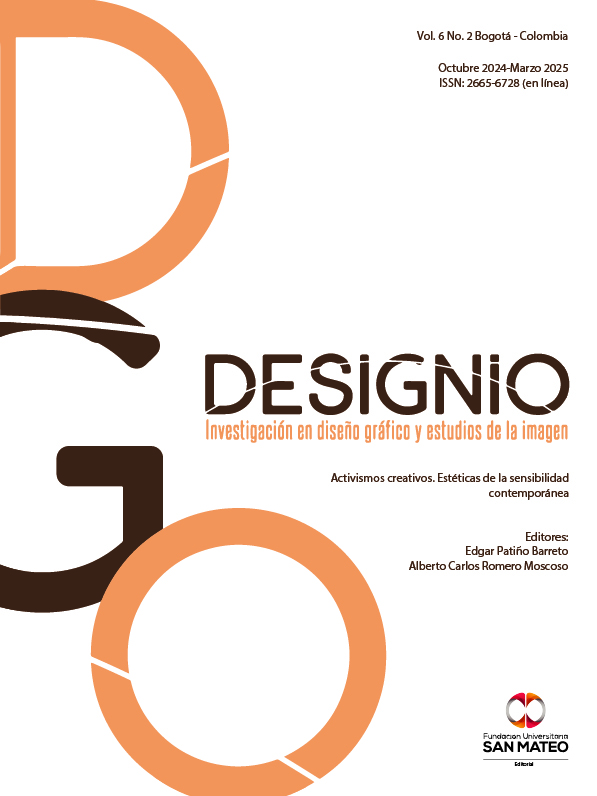Creative Activism in Soviet Wave Community Ghosts of a Dreamed Future
Main Article Content
Abstract
The aim of this article is to study the images of the soviet wave musical genre from the aesthetic function of nostalgia as a result of the temporal rupture that the fall of the former Soviet Union and other related disasters such as Chernobyl meant. To this end, the article studies the aesthetic function of nostalgia as a creative artistic and cultural project that ultimately manages to develop an aesthetic sensibility, but which implies a political anti-activism, since it does not restore the old political, artistic, economic and social forms, nor does it produce new active forms of sensibility. The images and lyrics of the soviet wave genre project a nostalgic sensibility that keeps them within a mercantile logic or one of social failure. Consequently, nostalgia cannot generate political activism because it refers to inactivity, rather than action. The article is divided into two parts. The first part studies the temporal resizing after the fall of the former Soviet Union and the Chernobyl disaster as triggering events to propose that the soviet wave establishes three aesthetic categories based on the new temporal perception: melancholy, nostalgia and “retro”. The second part studies the nostalgic or “retro” images produced by the new technological devices that shape the soviet wave aesthetic, based on a multimodal analysis of the construction of meaning in the image. In conclusion, it is possible to postulate that the soviet wave functions as an exposition of the crisis of social democracy and current capitalism in its neoliberal version by means of technical devices and forms of visual organization that recall the seventies and eighties.
Downloads
Article Details

This work is licensed under a Creative Commons Attribution-NonCommercial-NoDerivatives 4.0 International License.
References
Alexievich, S. (2015). Voces de Chernóbil. Crónica del futuro. Debolsillo.
Asociación de Medicinas Complementarias. (1986). Chernóbil 20 años después. Revista de Medicinas Complementarias. Medicina Holística, (79).
Ballam-Cross, P. (2021). Reconstructed Nostalgia: Aesthetic Commonalities and Self-Soothing in Chillwave, Synthwave, and Vaporwave. Journal of Popular Music Studies, 33(1). https://doi.org/10.1525/jpms.2021.33.1.70
Bartholeyns, G. (2014). The Instant Past: Nostalgia and Digital Retro Photography. En K. Niemeyer (Ed.), Media and Nostalgia (pp. 51-69). Palgrave Macmillan. https://doi.org/10.1057/9781137375889_4
Boucher, E. (2014, octubre 10). Eco Virtual’s Latest Album Revives Vaporwave Aesthetic. The Trail. http://trail.pugetsound.edu/?p=10918.
Boym, S. (2015). El futuro de la nostalgia. A. Machado Libros.
Casey, E. (1987). The World of Nostalgia. Man and World, 20, 361-384. https://doi.org/10.1007/BF01252103
Cliff, A. (2013, julio 29). Invest in Vaporwave Futures! Dummy. https://dmy.co/features/essay-invest-in-vaporwave-futures
Cole, R. (2020). Vaporwave Aesthetics: Internet Nostalgia and the Utopian Impulse. ASAP/Journal 5(2), 297-326. https://doi.org/10.1353/asa.2020.0008.
Cope, B. y Kalantzis, M. (2010). Gramática de la multimodalidad. Boletín de la Asociación Andaluza de Bibliotecarios, (98-99), 93-154.
Del Río, F. (2019, noviembre 4). Entrevistamos a Molchat Doma. Muzikalia. https://muzikalia.com/entrevistamos-molchat-doma/
DaSilva, F. & Faught, J. (1982). Nostalgia: A Sphere and Process of Contemporary Ideology. Qualitative Sociology, 5(1), 47-61.
Fisher, M. (2018). Los fantasmas de mi vida. Escritos sobre depresión, hauntología y futuros perdidos. Caja negra.
Fitzpatrick, S. (2009). La revolución rusa. Siglo XXI.
Fontana, J. (2017). El siglo de la revolución. Una historia del mundo desde 1914. Crítica.
Gjuričová, A. (2021). History Reloaded: The Communist Past in Digital Space. Iluminace, 33(3), 27-42.
Guesdon, M. & Le Guern, P. (2014). Retromania: Crisis of the Progressive Ideal and Pop Music Spectrality. En K. Niemeyer (Ed.), Media and Nostalgia. Yearning for the Past, Present and Future (pp. 70-82). Palgrave Macmillan.
Hoskins, A. (2018). Digital media and the precarity of memory. En M. Meade et al. (Eds). Collaborative Remembering: Theories, Research, and Applications. Oxford.
Hosking, G. (2014). Una muy breve historia de Rusa. Alianza Editorial.
INSST. (1999). El radón y sus efectos sobre la salud (NTP 533). https://www.insst.es/documentacion/colecciones-tecnicas/ntp-notas-tecnicas-de-prevencion/15-serie-ntp-numeros-506-a-540-ano-2000/ntp-533-el-radon-y-sus-efectos-sobre-la-salud
Kosselleck, R. (2001). Los estratos del tiempo: estudios sobre la historia. Paidós.
Landsberg, A. (2004). Prosthetic Memory. The Transformation of American Remembrance in the Age of Mass Culture. Columbia University Press.
Lewin, M. (2017). El siglo soviético ¿Qué sucedió realmente en la unión Soviética? Crítica.
Molchat Doma. (2017). Я Не Коммунист [Canción]. En С крыш наших домов. Sacred Bones Records.
Maury, J.O. (2021). Its All in Your Head: La construcción de una nostalgia por futuros perdidos desde la mediación tecnológica en la música del vaporwave. [Trabajo de grado, Pontificia Universidad Católica del Perú]. Repositorio institucional PUCP. http://hdl.handle.net/20.500.12404/21646
Pickering, M. & Keightley, E. (2014). Retrotyping and the Marketing of Nostalgia. En K. Niemeyer (Ed.), Media and Nostalgia. Yearning for the Past, Present and Future (pp. 83-94). Palgrave Macmillan.
Reynolds, S. (2012). Retromanía. La adicción del pop a su propio pasado. Caja Negra.
Ruano-Ravina, A. Quindós-Poncela, L., Sainz, C. y Barros-Dios, J. (2014). Radón interior y salud pública en España. Tiempo para la acción. Gaceta Sanitaria, 28(6), 439-441.
Santamarta, J. (2001). El cierre de Chernóbil no acaba con la pesadilla nuclear. Papeles del Este: Transiciones Poscomunistas, (2). https://dialnet.unirioja.es/servlet/articulo?codigo=639823
Sommer, Vítězslav. (2021). Decommunization as a Digital Utopia: Digitization of the Communist State Security Archives in the Czech Republic. Střed, 13(1), 82-109.
Sound Station. (2015, junio 18). entering the plaza... (Assorted Vaporwave Mix/Compilation #2 | 2+ Hours) [Video]. YouTube. https://www.youtube.com/watch?v=ea_UOPzuyZU
Tanner, G. (2016). Babbling Corpse: Vaporwave and the Commodification of Ghosts. Zero Books.
Traverso, E. (2019). Melancolía de izquierda. Después de las utopías. Galaxia Gutenberg.
Tondeur, A. y Marder, M. (2021). Chernóbil Herbarium. Fragmentos de una conciencia explotada. NED Ediciones.
Ui小毛毛.(s.f.). Viajes. Pinterest. https://mx.pinterest.com/pin/845550898768098150/
Wiseman-Trowse, N. (2008). Performing Class. En Performing Class in British Popular Music (pp. 62-87). Palgrave Macmillan, London. https://doi.org/10.1057/9780230594975_4

